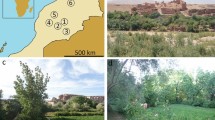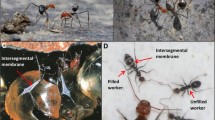Summary
Hamilton's (1964) hypothesis linking haplodiploidy and eusociality in the Hymenoptera could be reconciled with the occurrence of polygyny and multiple insemination if workers are able to distinguish full (3/4 related) sisters from other familiar matri- and patrilines within the colony, and direct altruistic behavior toward them preferentially. We examined this possibility in small genetically mixed nests of the carpenter ant Camponotus floridanus, formed by the transfer of worker pupae from two unrelated source colonies. In 120 h of observation on 12 queenright and 12 queenless nests, more than 15,000 behavioral interactions were recorded. Workers antennated familiar nonkin significantly more frequently than familiar sisters. However, they failed to discriminate consistently between kin and non-kin in food exchanges and grooming. Aggressive behavior was occasionally observed in some queenless nests, but almost never in the presence of a queen. When aggression did occur, it was directed significantly more often toward non-kin. Though related adult workers did not cooperate preferentially, the biases in antennation and aggression do indicate an ability to discriminate familiar kin from familiar nonkin, which may be employed in other contexts such as the rearing of reproductive brood.
Similar content being viewed by others
References
Bhatkar A, Whitcomb WH (1970) Artificial diet for rearing various species of ants. Fla Entomol 53:229–232
Breed M, Butler L, Stiller T (1985) Kin discrimination by worker honey bees in genetically mixed groups. Proc Nat Acad Sci USA 82:3058–3061
Breed M, Velthuis HHW, Robinson GE (1984) Do worker honey bees discriminate among unrelated and related larval phenotypes? Ann Entomol Soc Am 77: 737–739
Buckle G, Greenberg L (1981) Nestmate recognition in a sweat bee (Lasioglossum zephyrum): Does an individual recognize its won odors, or only odors of its nestmates? Anim Behav 29:802–809
Calabi P (1986) Division of labor in the ant Pheidole dentata: The role of colony demography and behavioral flexibility. PhD thesis, Boston University
Carlin NF, Hölldobler B (1983) Nestmate and kin recognition in interspecific mixed colonies of ants. Science 222:1027–1029
Carlin NF, Hölldobler B (1986) The kin recognition system of carpenter ants I: Hierarchical cues in small colonies. Behav Ecol Sociobiol 19:123–134
Carlin NF, Hölldobler B (1987) The kin recognition system of carpenter ants II: Larger colonies. Behav Ecol Sociobiol 20:209–217
Cole BJ (1981) Dominance hierarchies in Leptothorax ants. Science 212:83–84
Craig R, Crozier R (1979) Relatedness in the polygynous and Myrmecia pilulosa. Evolution 33:335–341
Crozier R (1977) Genetic differentiation between populations of the ant Aphaenogaster “rudis” in the southeastern United States. Genetica 47:17–36
Crozier R (in press) Genetic aspects of kin recognition: Concepts, models and synthesis. In: Fletcher DJC, Michener CD (eds) Kin recognition in animals. Wiley and Sons, New York
Crozier R, Pamilo P, Crozier Y (1984) Relatedness and microgeographic genetic variation in Rhytidoponera mayri, an Australian arid-zone ant. Behav Ecol Sociobiol 15:143–150
Denning P, Dennis J, Qualitz J (1978) Machines, languages and computation. Prentice-Hall Inc, Englewood Cliffs, New Jersey
Dobrzanski J (1966) Contribution to the ethology of Leptothorax acervorum (Hymenoptera: Formicidae). Acta Biol Exp 26:71–78
Errard C, Jaisson P (1984) Etude des relation sociales dans les colonies mixtes heterospecificques chez les fourmis (Hymenoptera, Formicidae). Folia Entomol Mex 61:135–146
Evers C, Seeley T (1986) Kin discrimination and aggression in honey bee colonies with laying workers. Anim Behav 34:924–925
Fielde AM (1903) Artificial mixed nests of ants. Biol Bull 5:320–325
Franks N, Scovell E (1983) Dominance and reproductive success among slave-making worker ants. Nature 304:724–725
Frumhoff PC, Schneider S (1987) The social consequences of honeybee polyandry: Kinship influences worker interactions within colonies. Anim Behav (in press)
Gadagkar R (1985) Kin recognition in social insects and other animals—a review of recent findings and a consideration of their relevance for the theory of kin selection. Proc Indian Acad Sci (Anim Sci). 94:587–621
Gamboa G, Reeve H, Pfennig D (1986) The evolution and ontogeny of nestmate recognition in social wasps. Ann Rev Entomol 31:431–454
Getz WM, Bruckner D, Parisian TR (1982) Kin structure and swarming behavior of the honey bee Apis mellifera. Behav Ecol Sociobiol 10:265–270
Getz WM, Smith KB (1983) Genetic kin recognition: Honey bees discriminate between full and half sisters. Nature 302:147–148
Greenberg L (1979) Genetic component of bee odor in kin recognition. Science 206:1095–1097
Hamilton WD (1964) The genetical theory of social behavior II. J Theor Biol 7:17–52
Hölldobler B (1973) Formica sanguinea (Formicidae): Futterbetteln. Encyclopedia Cinematographica, E2013, Göttingen
Hölldobler B, Bartz S (1985) Sociobiology of reproduction in ants. In: Hölldobler B, Lindauer M (eds) Experimental behavioral ecology and sociobiology. Fortschritte der Zoologie 31:237–258 (Fischer, Stuttgart and Sinauer, Sunderland, Mass)
Hölldobler B, Michener CD (1980) Mechanisms of identification and discrimination in social Hymenoptera. In: Markl H (ed) Evolution of social behavior: Hypotheses and empirical tests. VCH, Weinheim, pp 35–58
Holmes WG, Sherman PW (1983) Kin recognition in animals. Am Sci 71:46–55
Isingrini M, Lenoir A, Jaisson P (1985) Preimaginal learning as a basis of colony-brood recognition in the ant Cataglyphis cursor. Proc Nat Acad Sci USA 82:8545–8547
Jaffe K, Sanchez C (1984) On the nestmate-recognition system and territorial marking behaviour in the ant Camponotus rufipes. Insect Soc 31:302–314
Lester L, Selander R (1981) Genetic relatedness and the social organization of Polistes colonies. Am Nat 117:147–166
Metcalf R, Whitt G (1977) Intra-nest relatedness in the social wasp Polistes metricus: A genetic analysis. Behav Ecol Sociobiol 2:339–351
Mintzer A (1982) Nestmate recognition and incompatibility between colonies of the acacia ant Pseudomyrmex ferruginea. Behav Ecol Sociobiol 10:165–168
Page R, Erickson E (1984) Selective rearing of queens by worker honey bees: Kin or nestmate recognition. Ann Entomol Soc Am 77:578–580
Page R, Metcalf R (1982) Multiple mating sperm utilization and social evolution. Amer Nat 119:263–281
Pamilo P (1982) Genetic population structure in polygynous Formica ants. Heredity 48:95–106
Pearson B (1983) Ihtra-colonial relatedness amongst workers in a population of nests of the polygynous ant Myrmica rubra Latreille. Behav Ecol Sociobiol 12:1–4
Stuart R (1985) Nestmate recognition in leptothoracine ants: exploring the dynamics of a complex phenomenon. PhD thesis, University of Toronto
Visscher K (1986) Kinship discrimination in queen rearing by honeybees. Behav Ecol Sociobiol 18:453–460
Ward P (1983) Genetic relatedness and cology organization in a species complex of ponerine ants I: Phenotypic and genotypic composition of colonies. Behav Ecol Sociobiol 12:285–299
Wilson EO (1971) The insect societies. Beknap Press of Harvard University Press, Cambridge, Mass
Author information
Authors and Affiliations
Rights and permissions
About this article
Cite this article
Carlin, N.F., Hölldobler, B. & Gladstein, D.S. The kin recognition system of carpenter ants (Camponotus spp.). Behav Ecol Sociobiol 20, 219–227 (1987). https://doi.org/10.1007/BF00299736
Received:
Accepted:
Issue Date:
DOI: https://doi.org/10.1007/BF00299736




